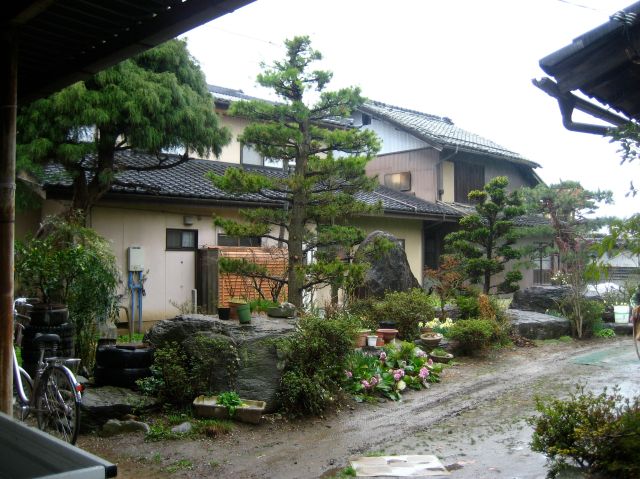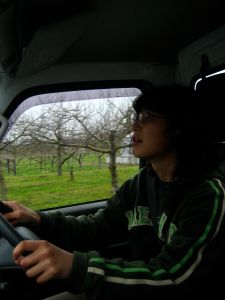It’s only after some time looking at the little garden feature of trees, rocks, plants, flowers and bushes do I realize what it actually is. It’s a border, separating the Kobayashi family from the neighbouring Miki family. There are many other houses all around the Kobayashi household and there appears to be a very liberal attitude to border delineation between them all: a bush here, an open path there, a little garden allotment here. It’s been well observed that Irish people have a pathology about land: there’s a fixation on owning it, a conviction that it’s a “good investment” and an obsession with protecting its boundaries. I’m so surprised by the absence of clear barriers of separation: no high walls, electric fences or solid bushes, that I guess, you could diagnose me as still suffering from culture shock.
After staying indoors for a few hours to keep out of the rain, we realize that the weather isn’t going to clear up. It’s been a lazy day so far, but after lunch we’re both keen to get out of the house and “do something”, so in the end we decide to go for a drive into Suzaka. To get there, we go in the little Mazda scrum truck, which Sachiko expertly steers through the little country lanes that cross and criss-cross the numerous orchards of peach, pear, apple and cherry trees in the area.
Suzaka is a town of about 50,000 people. It’s a quite country town nestled picturesquely in the foot hills of Mt. Azuma, Kamata and Yonako. Our destination is the Suzaka hanga museum, but first we call into the local library, which is quite packed with people keeping out of the rain. We drive through the hilly, narrow streets to get to the museum. The cherry blossoms are out, but like everything else, they look dreary in the rain.
When we arrive at the museum on the outskirts of town, we leave our truck in the car park and walk up the meandering tree-lined path towards the museum. Along the way are some colourful and jolly clay figurines. Plastic bottles have been cut up and placed as rain-guards over their heads and this seems to accentuate their merry appearance. If they could sing, I’m sure it would be something cheerful like “I’m Singing In The Rain…”
We go into an austere looking stone building, the hanga museum: hanga meaning print. The first part of the museum is dedicated to an artist called Asaji Kobayashi who was born in Suzaka in 1898. An eye-doctor by profession, his talent for art didn’t go unrecognized and the museum has plenty of his posters, wood cuts and prints. Asaji was active in the 1920s and 1930s, a period when Japan was convulsed with change and was modernizing rapidly. Some of his images of the “New Japan” show the recently imported sport of skiing in the local mountains. Skiing was reputedly introduced into Japan in the early 1900s by Major Theodor von Lerch of the Austrian Army. Tragically, Asaji Kobayashi committed suicide in 1939.
Some of the other artists we see are Hiratsuka Unichi…
Koshiro Onchi…
Kyokichi Tanaka…
and Yasunori Taninaka.
After we leave the museum we go into a tiny folk park which is full of reconstructed old houses from the Edo period. This was the period of long peace in Japanese history from 1600 to the 1860s when Japan was completely closed off to the world. Most of the dwellings are wooden and many of them are thatched.
We loll around, checking out the tatami flooring, sliding doors of thin paper. There’s a distinct lack of furniture, it seems most Japanese homes at the time didn’t have chairs. We also take a minute to practice an important Japanese cultural practice: bowing.
The dwellings make a virtue of simplicity.
In his insightful and witty book, The Book of Tea, Kakuzo Okakura contrasted the simple, elegant aesthetic of Japanese tea-rooms with the busy interior of Western living rooms.
“Thus it will be seen that the system of decoration in our tea-rooms is opposed to that which obtains in the West, where the interior of a house is often converted into a museum. To a Japanese, accustomed to simplicity of ornamentation and frequent change of decorative method, a Western interior permanently filled with a vast array of pictures, statuary, and bric-a-brac gives the impression of mere vulgar display of riches. It calls for a mighty wealth of appreciation to enjoy the constant sight of even a masterpiece, and limitless indeed must be the capacity for artistic feeling in those who can exist day after day in the midst of such confusion of color and form as is to be often seen in the homes of Europe and America.”
Driving back from the museum, we see lots of other little scrum trucks like ours. They’re quite popular with all the local farmers (they’re very useful for transporting various goods). Many of them also have a conspicuous orange sticker which indicates that the driver of the vehicle is over 75 years old; it’s a koreisha mark, literally “elderly mark”. This hasn’t been uncontroversial: many families have arguments with their old relatives who initially refuse to put the koreisha mark on their vehicle. As well as that, a recent campaign protesting the autumnal colour of the koreisha mark, which was seen as being too suggestive of aging and death, was launched and became successful when in February 2011, a more colourful koreisha mark was introduced. For a country with the highest life expectancy in the world (86 for woman, 79 for men), it’s heartening to see that the oldies can still put up a good fight.
When we get back to the house in Ainoshima village, Sachiko makes a call and arranges to meet some friends in a local restaurant. It’s still raining, but the restaurant is only a few metres down the road so we run the short distance to Tora Shokudo. It’s a simple, humble venue. We go inside and the one table of old men all look over. One of the men stands up and welcomes us.
“Irasshaimase!”
He is the owner of the restaurant and he speaks to Sachiko in a friendly tone. She has grown up here and the two are lifelong neighbours. My immediate impressions are of a small, friendly restaurant, “where everybody knows your name”. But as it turns out, the owner is also a Kobayashi, and this somewhat takes the glow off the impression of neighbourliness, “…because they all have the same name as you”.
The continued attention from the table of older men, slowly starts to alter my impression of the restaurant. This isn’t cosmopolitan Tokyo, where people don’t bat an eyelid at a foreigner; this is Ainoshima, a tiny village on the edge of a country town in a farming region. A native girl arriving into a local restaurant with a foreign male is a bit of an event, there’s almost a whiff of scandal… and so the table of old men all continue to stare over, completely unable to conceal their excitement. The owner speaks to Sachiko and when I hear her say “Irelulando”, I can guess what he’s asking her.
“Thank you bery much!” the owner says to me. I give a friendly bow.
After a short chat, the owner tells us to choose our seats; apart from the table of old men, every other table in the restaurant is free. We choose a table at the opposite end of the restaurant to the old men and we sit down on the cushions, on the floor. After a few minutes June arrives, and a few minutes later, Atsuko, his wife arrives too. They’ve both come straight from work: June is a plumber and Atsuko is a delivery driver. Neither of them have gotten dressed up for the dinner and both are wearing clothes that confirm they’ve done a full day’s work. I like this. It’s nice to spend some time with the Japanese without all the formalities. Introductions are made, and we greet each other with friendly bows and lots of “hajimemashte”.
I go for the local speciality: nikatsu teishoku, deep fried Nagano pork, with fried egg on top and it comes with rice and miso soup – the last two are the perennials of Japanese food. The meal is the Japanese equivalent of meat and two veg: good solid food. It’s delicious, and very filling.
Over dinner we chat away, and just like with Sachiko’s father the night before, the first question I’m asked is if I’ve heard of the Japanese earthquake on March 11th. We talk a little about the consequences, and they both tell me how bad it was. The conversation moves on and quickly we’re talking about Japanese food. I praise it, making maximum use of the few Japanese words I’ve learned:
“Subarashi!” (fantastic)
“Sugoi!” (super)
“Oishi!” (delicious)
It might sound like love-bombing, but it’s true: I love Japanese food. Just like Sachiko’s parents, June & Atsuko compliment my chopstick technique. As a way to charm the Japanese people, I’m reminded of the phrase, the way to a man’s heart is through his stomach. However, this chopstick praise comes back to haunt me.
During the closing stages of the (substantial) meal, but before I’ve completely finished, I take a break. It’s bad manners to leave food on your plate when you’re eating in Japan and I’m fully intent on eating every last morsel. There’s an array of little bowls and plates before me and while I pause, I leave my chopsticks in the rice bowl: foolishly, I leave them skewered and erect like a flag pole. Thus do I commit a big no-no. Atsuko is the first to react.
“Sachiko!” she exclaims in shock. Her tone suggests I’m a little kid who has just set himself on fire. June is too stunned even to speak, he just widens his eyes in disbelief and horror.
I realize pretty quickly what I’ve done wrong. In a lapse of concentration, I inserted my chopsticks vertically into my rice, so I rapidly recover them and leave them resting across my bowl. There is huge relief on June & Atsuko’s face.
“Definitely a hara-kiri moment”, I say and we all laugh it off.
The reason behind the explosive reaction to me leaving my chopsticks sticking up in rice is simple: it’s a gesture exclusively reserved for serving food to the dead. Most Japanese families have a simple Buddhist shrine in their home dedicated to their ancestors who have passed on. A daily act of veneration involves leaving a bowl of freshly cooked rice before the shrine and placing the chopsticks in the bowl, erect. Nowhere else is this chopstick gesture used. I had been warned about this by Sachiko but in the course of the meal I had simply forgotten. I very nearly paid the ultimate price…

















Looks like you had a lot of fun despite all the rain. I don’t mind the rain at times and especially around the mountains as it makes an amazing view.
It only rained for one day, so it wasn’t too bad. We were able to get out the next day and actually see the mountains through all the rain!
Great story, Fionn. I feel as if I have been there in the restaurant looking over your shoulder, eavesdropping. Interesting about the boundaries and the comparison with Ireland. We are certainly very fond of them now but I believe they only a ‘recent’ arrival in Ireland, having been introduced by the Normans!
Good luck in your travels,
Sheila Sugrue
Hi Sheila. Thanks for the comment. It’s hard not to compare everything back to Ireland when you’re travelling in a place as different as Japan. Sometimes we come out of the comparison quite well, but a lot of the time, I’m left shaking my head!